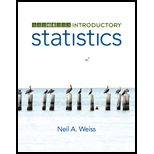
Concept explainers
a.
To explain: Whether the statement “For a random sample of 196 female marketing and advertising managers, chances are roughly 95% that the sample
b.
To explain: Whether the statement “Approximately 95% of all possible observations of the number of hours worked by female marketing and advertising managers lie between 31 hours and 59 hours” is true or false or whether the information is insufficient to decide.
c.
To explain: Whether the statement “For a random sample of 196 female marketing and advertising managers, chances are roughly 95% that the sample mean number of hours worked will be between 44 hours and 46 hours” is true or false or whether the information is insufficient to decide.
Want to see the full answer?
Check out a sample textbook solution
Chapter 7 Solutions
Introductory Statistics (10th Edition)
- A company found that the daily sales revenue of its flagship product follows a normal distribution with a mean of $4500 and a standard deviation of $450. The company defines a "high-sales day" that is, any day with sales exceeding $4800. please provide a step by step on how to get the answers in excel Q: What percentage of days can the company expect to have "high-sales days" or sales greater than $4800? Q: What is the sales revenue threshold for the bottom 10% of days? (please note that 10% refers to the probability/area under bell curve towards the lower tail of bell curve) Provide answers in the yellow cellsarrow_forwardFind the critical value for a left-tailed test using the F distribution with a 0.025, degrees of freedom in the numerator=12, and degrees of freedom in the denominator = 50. A portion of the table of critical values of the F-distribution is provided. Click the icon to view the partial table of critical values of the F-distribution. What is the critical value? (Round to two decimal places as needed.)arrow_forwardA retail store manager claims that the average daily sales of the store are $1,500. You aim to test whether the actual average daily sales differ significantly from this claimed value. You can provide your answer by inserting a text box and the answer must include: Null hypothesis, Alternative hypothesis, Show answer (output table/summary table), and Conclusion based on the P value. Showing the calculation is a must. If calculation is missing,so please provide a step by step on the answers Numerical answers in the yellow cellsarrow_forward
 Glencoe Algebra 1, Student Edition, 9780079039897...AlgebraISBN:9780079039897Author:CarterPublisher:McGraw Hill
Glencoe Algebra 1, Student Edition, 9780079039897...AlgebraISBN:9780079039897Author:CarterPublisher:McGraw Hill
